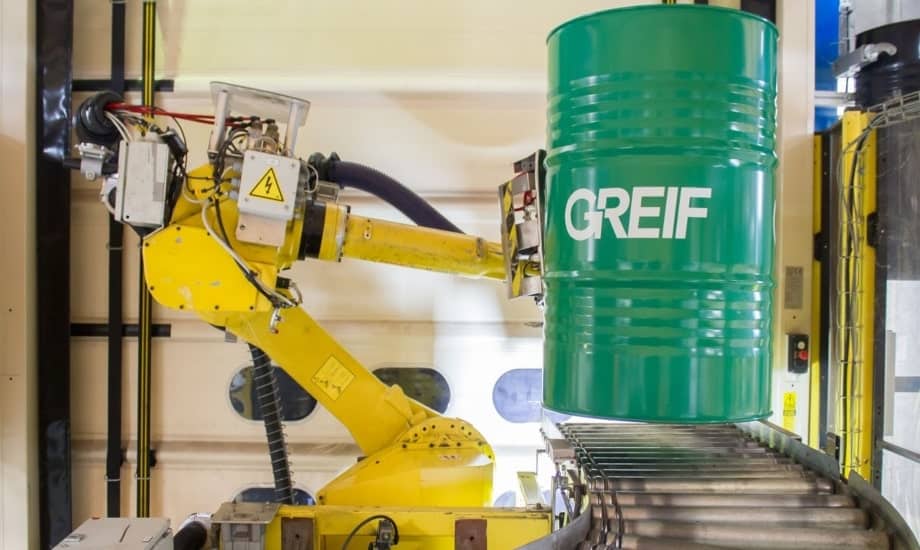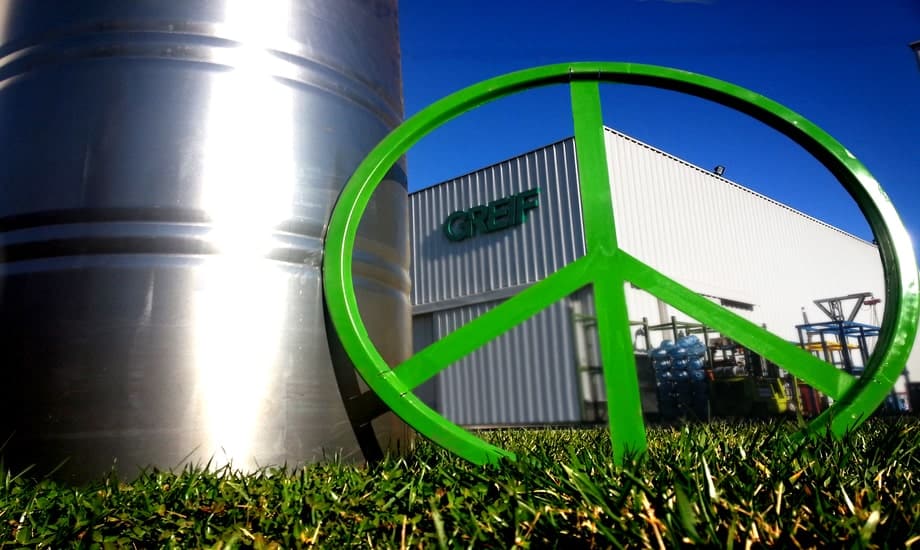ניהול סיכונים והמשכיות עסקית
ממשל
244
244 אתרים ברחבי העולם
הטווח הגלובלי שלנו קרוב אליך.
Greif מעריך סיכונים כלל-ארגוניים באמצעות תהליך ניהול סיכונים ארגוני (ERM) הפורמלי שלנו, המתחשב בכל היחידות העסקיות והגיאוגרפיות של Greif. מידע על סיכונים מזוהה ומנתח באמצעות תהליכי ניטור הסיכונים והתוכן של Greif על ידי ספקי הבטחה ברחבי הארגון, כולל מנהיגות ניהולית, ביקורת פנימית, משפטי/תאימות, משוב מלקוחות ומעורבות משקיעים וועדת ההיגוי לקיימות (SSC) של Greif. ה-SSC עוקב אחר דוחות התעשייה (כלומר, World Business Council for Sustainable Development (WBCSD) ESG Enterprise Risk Management Framework, WRI's הערכת נוף אנרגיה נקייה לאחר 2020, ו-CSSR הערכת אקלים לאומית רביעית), דירוגים ודירוגים של ESG, תמחור אנרגיה, תקנות ותוכניות ממשלתיות מתפתחות, ומחזיקה בקשרים רשמיים עם עמותות וארגונים לא ממשלתיים ספציפיים ל-ESG, כולל WBCSD וה-United Nations Global Compact, כדי לזהות סיכונים מתעוררים שעשויים להשפיע על העסק שלנו. מידע מקבוצות אלו, כולל סיכונים מתעוררים לטווח ארוך, מסופק לוועדת מנהיגי הסיכונים של גרייף (RLC), בהובלת מנהל הביקורת הראשי של גרייף, והיא מורכבת מחברי צוותי ההנהלה, היחידה העסקית והיחידה העסקית האסטרטגית של גרייף ומנהל הקיימות של גרייף. RLC מזהה, מדרג, סוקר ומתעדף סיכונים בשיתוף עם ועדת הביקורת של Greif כדי לקבוע את הסיכונים הקריטיים ביותר בהתבסס על השפעה פוטנציאלית והסבירות להתרחש. כל סיכון מוערך עבור הזדמנויות פוטנציאליות ומדווח לדירקטוריון מדי רבעון לאישור. סיכונים מוערכים על ידי RLC כדי לפתח תוכניות להפחתת סיכונים ולכידת הזדמנויות. ועדה זו מתכנסת מדי רבעון.
סיכונים והזדמנויות הקשורות לאקלים משולבים ישירות בתהליך ה-ERM הכולל שלנו ונחשבים לצד כל המידע המסופק על ידי ספקי הבטחה ברחבי הארגון. באמצעות תהליך זה, Greif זיהה אירועי מזג אוויר קיצוניים, מחיר חומרי גלם ותנודתיות באספקה ועליית מפלס הים כסיכוני האקלים המשמעותיים ביותר שלנו. בנוסף, בשנת 2020 באמצעות תהליך ה-ERM שלנו, זיהינו מגיפות כנושא בסיכון גבוה. למידע נוסף בנוגע לניהול הסיכונים שלנו הקשורים לאקלים, סיכונים והזדמנויות, אנא עיין בסעיף C2 שלנו תגובת CDP.
בשנת 2021 קיימנו סדנאות פנימיות כדי לפתח את ההבנה והמודעות של עמיתינו לסיכונים והזדמנויות הקשורות לאקלים. עמיתים מאזורים ומחלקות שונות השתתפו בסדנאות ושיתפו פעולה בצוותים מגוונים שהורכבו מאנשים עם מגוון מומחיות מגוון כדי לספק נקודות מבט ייחודיות. כל צוות היה אחראי על זיהוי סיכונים והזדמנויות מובילות, יצירת מפות חום של סיכונים והזדמנויות וסיעור מוחות של אסטרטגיות להפחתת סיכונים. הסיכונים וההזדמנויות חולקו לשלוש קטגוריות שונות: שוק, פיזי ורגולטורי. קבענו שחמשת הסיכונים המובילים הם מנגנוני תמחור פחמן, קטסטרופה טבעית, השגת חומרי גלם מתחדשים, שינוי בהעדפות הלקוחות ודרישת הלקוחות למוצרים בני קיימא. זיהינו גם שלוש עד חמש הזדמנויות לכל אחת משלוש הקטגוריות והתחלנו לבצע ניתוחי תרחישים על סיכוני הרגולציה והשווקים המשפיעים יותר. חישבנו גם את ההשפעה הכספית של הסיכונים שזוהו. התוצאות יוצגו לחברי צוות המנהיגות המנהלת (ELT) בשנת 2022 ויקבעו כיצד לכלול את הסיכונים באסטרטגיית ה-ERM שלנו ולפתח תוכנית לשילובם באסטרטגיות ה-BU שלנו. אנא בקר ב אסטרטגיית אקלים חלק מהדוח שלנו כדי ללמוד עוד על סדנאות האקלים שלנו.
החל משנת 2019, Greif החלה לשלב תוצאות מדוח המגמות הגלובלי הפנימי שלנו בתהליך ה-ERM שלנו. בהתבסס על ראיונות עם מנהיגים פנימיים ומחקר משני, הדו"ח מזהה שש מגמות גלובליות בעלות רלוונטיות מיוחדת לעסק שלנו:
- חברות הופכות לידידותיות יותר לסביבה
- דיגיטציה ואוטומציה של הייצור
- דיגיטציה של שרשרת אספקה ולוגיסטיקה
- דיגיטציה של רכש ארגוני ומכירה מעסק לעסקים
- מחסור בכוח אדם, עודפים ופערי מיומנות
- הזדמנויות צמיחה גדלות בשווקים מתעוררים
בשילוב עם מקורות פנימיים וחיצוניים אחרים שנחשבים בתהליך ה-ERM שלנו, דוח המגמה משפר את יכולתנו לחזות ולתכנן מגמות ארוכות טווח שעשויות להשפיע על העסק שלנו בעתיד. בתגובה למגמת "החברות נעשות ידידותיות יותר לסביבה", העלינו את הקיימות באסטרטגיה העסקית שלנו במיוחד ביחס לחדשנות, וכתוצאה מכך התמקדות מוגברת במוצרי שרף לאחר הצריכה (PCR), שיפוץ וצמיחת רשתות השיקום של מיכלי ביניים בתפזורת (IBC). למידע נוסף על דוח המגמות שלנו, עיין ב- חדשנות חלק בדוח הקיימות שלנו.
כתוצאה מהערכת המהותיות שלנו והערכת פערי ה-TCFD, שילבנו עדכוני קיימות והצהרות סיכונים ב-10K והצהרות ה-Proxy שלנו וכללו נושאים וסיכונים הקשורים ל-ESG בישיבות מועצת המנהיגות בשנת 2021. בחרנו גם ב-ESG כאזור עדיפות אסטרטגי של מועצת המנהיגות ב-2021, כאשר תחום המיקוד המרכזי היה הטמעת אקלים, עמידה בסביבת וקיימות שלנו. גיוון, שוויון והכלה - בתרבות שלנו, בהתנהגויות היומיומיות של עמיתים ובתהליכי ניהול סיכונים. בשנת 2021, התחלנו לדווח על מדדי קיימות עיקריים למועצת המנהיגות, לצוות המנהיגות המבצעת ולסגני הנשיא על בסיס קבוע, תוך מתן עדכוני קיימות רבעוניים לצוות המנהיגות המנהלת. פיתחנו גם שיטות תקשורת כדי לספק עדכוני קיימות שוטפים לארגון כולו, כולל עדכונים מרכזיים על סיכונים. תקשרנו באמצעות פגישות קבועות בעירייה, סמינרים מקוונים וסיורים וירטואליים במפעלים בנוסף לעדכוני חדשות שבועיים ופודקאסטים רבעוניים. אנו מתכננים להמשיך באסטרטגיות התקשורת הללו בשנת 2022.
כדי לשפר את היכולת שלנו להגיב למשברים פוטנציאליים, השקנו תוכנית לניהול משברים ב-2019. Greif שיתפה פעולה עם מערכת הודעות המוני צד שלישי כדי להשיק מערכת התראה שמסוגלת להודיע ולעדכן את עמיתינו באמצעות הודעת טקסט, שיחת טלפון, דואר אלקטרוני ואפליקציית סמארטפון בזמן חירום ומצבים משמעותיים המהווים סכנה או משבשים את פעולות העבודה. המערכת משמשת גם לכינוס צוות התגובה למשברים של גרייף, צוות של מנהיגים מנהלים האחראים על תיאום התקשורת והתגובה למשברים וביצוע פנקס המשבר של גרייף. בשנת 2020, כל המתקנים החדשים של Caraustar הוכשרו בפלטפורמה, הפעילה כעת בכל תיק העסקים של Greif. בשנת 2021, צוות תגובת המשבר שלנו הנחה שני תרגילים כלל-ארגוניים לתגובה למשבר, תרגיל אחד התמקד באבטחת סייבר והשני באסון תעשייתי. התרגילים מבטיחים שקיימים נהלים מתאימים כדי לתת מענה למקרי חירום בלתי צפויים.
המשכיות עסקית
תוכנית התאוששות/המשכיות עסקית שלנו, שהוקמה בשנת 2017 בעסקי האריזה התעשייתית הגלובלית שלנו (GIP), מנהלת סיכונים והמשכיות עסקית באמצעות יכולות יתירות מלאי וייצור, הערכות סיכונים במתקן ויחסי עבודה יזומים. התוכנית מתארת תהליך בן 25 שלבים לזיהוי הזמנות של לקוחות שעלולות להיות מושפעות אם אסון יפגע באחד מהמתקנים שלנו, לזהות מוצרים חלופיים העומדים במפרט הלקוח ומתקנים שמסוגלים לייצר את המוצרים שהזמינו לקוחותינו. אנו עורכים מדי חודש אסונות מדומים אקראיים כדי להבטיח שהתהליך מובן בארגון וניתן ליישם במקרה של אסון. התוכנית, ומדיניות ההמשכיות העסקית בנושא התאוששות מאסון, נבדקות מדי שנה. עמיתים ממכירות, שירות לקוחות, תפעול, שיווק ולוגיסטיקה מנהלים את התוכנית במקביל להנהגת היחידה העסקית.
הרשת הגלובלית של Greif של 250 מיקומים מאפשרת לנו לייצר מוצרים זהים במספר אתרים, מה שמעניק לנו את הגמישות לשנות את הייצור על סמך המלאי, צרכי הלקוחות או במקרה הבלתי סביר שתתרחש כיבוי. יכולת זו מתאפשרת על ידי ניהול מלאי מרכזי ותהליך תכנון המכירות והתפעול החזק שלנו (S&OP), המאפשר נראות לחומרים גולמיים ומוגמרים בכל המתקנים שלנו. כל מתקן מרב מקורות חומרי גלם, מה שמבטיח שהייצור לא יופסק עקב עיכובים או מחסור מספק.
המתקנים של Greif עוברים מדי פעם בדיקות הנדסיות בקרת אובדן על ידי חברת ביטוח הרכוש שלנו. בדיקות אלו מבוצעות על ידי מהנדסים ומתמקדות בזיהוי סיכונים למתקן, לרבות אלו שעלולים להיגרם כתוצאה מאסונות טבע, ודרכים לצמצום ובקרה של סיכונים אלו. אנו מבצעים השקעות הון במתקנים שלנו כדי להפחית את הסיכונים שזוהו בבדיקות אלו. לדוגמה, Greif פתח לאחרונה מתקן חדש בפנסילבניה. במהלך תהליך בחירת האתר, הערכנו את הסיכון להצפה כדי להבטיח שהמתקן החדש לא ממוקם באזור הצפה. כמו כן, התקנו מערכת ספרינקלרים בהתאמה אישית כדי להגן בצורה הטובה ביותר על המתקן במקרה מצער של שריפה. בשנת 2021 עברנו למודל הקצאת סיכון לביטוח רכוש. השינוי איפשר לנו לקבל תעריפים משופרים על הכיסוי לאתרים שמוכנים טוב יותר לסיכון הקשור באסון טבע. מודל ביטוח זה משמש כזרז להנעת שיפורים לאורך זמן.
בשנת 2021, התמודד גרייף עם אתגרים רבים הקשורים לסופות החורף בטקסס. כדי להתכונן, קיימנו מספר פגישות ויישמנו את פרוטוקולי ניהול המשברים שלנו לפני הסערה. סגרנו את הציוד וסגרנו את המפעלים כדי לתת לכוח העבודה שלנו זמן לעשות סידורים. נאבקנו במחסור בכוח, בצנרת מים שבורה ובמערכת כיבוי אש התפוצצה. הפסקנו את הפעילות למספר ימים כדי לתעדף את הבטיחות של עמיתינו ובני משפחותיהם. לאחר מכן הבטחנו את הבטיחות והשלמות של המתקנים שלנו לפני שהקולגות שלנו חזרו לעבודה.
עם תחילת מגיפת ה-COVID-19, יצרנו כוחות משימה גלובליים ואזוריים של מגיפה כדי להבטיח שאנו שומרים על בריאותם של עמיתינו ועל המשכיות האספקה והשירות ללקוחותינו המוערכים. כוחות המשימה הללו נפגשו לפחות מדי שבוע כדי להבטיח שנוכל להמשיך בפעילות ולשמור על בטיחות עמיתים. כעסק חיוני, הצלחנו להמשיך לפעול כמעט בכל מתקני הייצור שלנו ביותר מ-40 מדינות. הפורטפוליו הגלובלי שלנו הוכיח את יכולתנו למלא את צרכי הלקוחות ברחבי העולם בתנאים מאקרו כלכליים מאתגרים. כדי להמשיך לעמוד בהתחייבויות שלנו ללקוחותינו, מינפנו את פרוטוקול ההתאוששות הקיים מאסון טבע שלנו. פרוטוקול זה דורש שכל המוצרים חייבים להיות מסוגלים לייצר במשותף במספר מתקנים ושכל מתקן חייב לנהל רשימת ספקים חלופיים עבור 35 החומרים המובילים המשמשים במתקן. רשימות ספקים אלו נשמרות כדי להבטיח את המשכיות האספקה ושניתן לשמור על ייצור Greif במקרה שספק נפגע מאסון טבע או אירוע אחר.
אנו רואים גם את הסיכון של סכסוכי עבודה להמשכיות העסקית. אנו מנהלים הסכמים קיבוציים על ציר זמן של שנתיים עד שלוש שנים, לא רק כאשר מו"מ צריך להתקיים. ההנהגה הבכירה שלנו בונה באופן פעיל קשרים עם הנהגת האיגודים והחברים בכל מפעל. גישה פרואקטיבית זו מבטיחה יחסי עבודה חיוביים והמשכיות עסקית.
שימוש באסטרטגיות ביטוח מתאימות
במהלך השנים האחרונות, Greif התמודד עם אתגרים חדשים ונוספים בגלל שריפות. כדי להפחית סיכונים הקשורים לאופי המפריע של אירועים אלה, אנו מפעילים אסטרטגיות ביטוח חדשות. אנו שומרים על סיכונים אלו בחזית גישת ניהול הסיכונים שלנו ושוקלים כיצד השפעות שינויי האקלים עשויות לתרום עוד יותר לסיכונים אלו.

שמירה על המחויבות שלנו באמצעות אסונות טבע
בשנת 2020, הוריקנים שנעו במפרץ מקסיקו השפיעו על מפעלי המיחזור הנייד, ביי מנטה ו-Woodbine Paper Packaging & Services (PPS) ודריסה השפיעה על מפעל טמה, איווה שלנו. בכל המקרים, עבדנו כדי לספק ללקוחות באמצעות קיבולת במקומות אחרים, שכן המפעלים עמדו בפני השבתה של חצי יום עד יומיים, בהתאם לאירוע. תוכניות ההמשכיות העסקית שלנו הבטיחו שזמן ההשבתה לא הוביל לאיבוד עסק ומילאנו את ההבטחות שלנו ללקוחותינו.
בשנת 2021, המתקנים שלנו בטקסס הושפעו מסופות חורף קשות. חוקקנו את הפרוטוקולים שלנו לניהול משברים וסגרנו את המתקנים שלנו כדי להבטיח את הבריאות והבטיחות של עמיתינו. המתקנים שלנו היו סגורים בין ארבעה לעשרה ימים כדי לאפשר מספיק זמן להחזיר את החשמל ולתקן נזקים. מכיוון שסופות החורף השפיעו גם על הלקוחות המקומיים שלנו, אספקת הלקוחות שלנו לא הושפעה. שמרנו על בטיחות עמיתים במהלך הסערות ותעדפנו סביבת עבודה בטוחה לעמיתינו לפני שהם חזרו למתקנים שלנו.

דגשים בנושא קיימות
244
244 אתרים מסביב לעולם
הטווח הגלובלי שלנו קרוב אליך.
145
שנים של ניסיון
ב-144 השנים האחרונות, המוצרים החשובים בעולם הסתובבו ברחבי העולם באריזות תעשייתיות של Greif.



